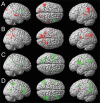Processing of intentional and automatic number magnitudes in children born prematurely: evidence from fMRI
- PMID: 25090014
- PMCID: PMC4270260
- DOI: 10.1080/87565641.2014.939179
Processing of intentional and automatic number magnitudes in children born prematurely: evidence from fMRI
Erratum in
- Dev Neuropsychol. 2014;39(8):646
Abstract
This study examined the neural correlates of intentional and automatic number processing (indexed by number comparison and physical Stroop task, respectively) in 6- and 7-year-old children born prematurely. Behavioral results revealed significant numerical distance and size congruity effects. Imaging results disclosed (1) largely overlapping fronto-parietal activation for intentional and automatic number processing, (2) a frontal to parietal shift of activation upon considering the risk factors gestational age and birth weight, and (3) a task-specific link between math proficiency and functional magnetic resonance imaging (fMRI) signal within distinct regions of the parietal lobes-indicating commonalities but also specificities of intentional and automatic number processing.
Figures



References
-
- Aarnoudse-Moens C. S., Weisglas-Kuperus N., van Goudoever B., Oosterlaan J. Meta-analysis of neurobehavioral outcomes in very preterm and/or very low birth weight children. Pediatrics. 2009:717–728. - PubMed
-
- Ansari D. Effects of development and enculturation on number representation in the brain. Nature Reviews Neuroscience. 2008:278–291. - PubMed
-
- Ansari D., Dhital B. Age-related changes in the activation of the intraparietal sulcus during nonsymbolic magnitude processing: An event-related functional magnetic resonance imaging study. Journal of Cognitive Neuroscience. 2006:1820–1828. - PubMed
-
- Ansari D., Garcia N., Lucas E., Hamon K., Dhital B. Neural correlates of symbolic number processing in children and adults. Neuroreport. 2005:1769–1773. - PubMed
-
- Arsalidou M., Taylor M. J. Is 2+2=4? Meta-analyses of brain areas needed for numbers and calculations. Neuroimage. 2011:2382–2393. - PubMed
Publication types
MeSH terms
Grants and funding
LinkOut - more resources
Full Text Sources
Other Literature Sources
Medical
